
Tully is a town and locality in the Cassowary Coast Region, Queensland, Australia. It is adjacent to the Bruce Highway, approximately 140 kilometres (87 mi) south of Cairns by road and 210 kilometres (130 mi) north of Townsville. At the 2016 census, the population was 2,390. Tully is perhaps best known for being one of the wettest towns in Australia, and home to the 7.9 metre tall Golden Gumboot.

Innisfail is a regional town and locality in the Cassowary Coast Region, Queensland, Australia. The town was originally called Geraldton until 1910. In the 2016 census, the town of Innisfail had a population of 7,236 people, while the locality of Innisfail had a population of 1,145 people.

The Shire of Johnstone was a local government area of Queensland. It was located on the Coral Sea coast about 90 kilometres (56 mi) south of the city of Cairns. The shire, administered from the town of Innisfail, covered an area of 1,639.1 square kilometres (632.9 sq mi), and existed as a local government entity from 1881 until 2008, when it amalgamated with the Shire of Cardwell to form the Cassowary Coast Region.

Innisfail Court House is a heritage-listed court house at 10 Edith Street, Innisfail, Cassowary Coast Region, Queensland, Australia. It is the town’s third court house. It was designed in the inter-war classical style by the Department of Public Works (Queensland) and built in 1939 by day labour. The current court house is a two-storeyed brick building with a corrugated-iron roof. It was added to the Queensland Heritage Register on 13 January 1995.

Finch Hatton railway station is a heritage-listed former railway station at Mackay-Eungella Road, Finch Hatton, Mackay Region, Queensland, Australia. It was built in 1904. It is also known as Hatton railway station and Pelion railway station. It was added to the Queensland Heritage Register on 6 December 2004.

Pioneer Shire Council Building is a heritage-listed town hall at 1 Wood Street, Mackay, Mackay Region, Queensland, Australia. It was designed by Harold Vivian Marsh Brown and built in 1935 by William Patrick Guthrie. It was added to the Queensland Heritage Register on 7 December 2007.

Proserpine Hospital is a heritage-listed public hospital at Herbert Street, Proserpine, Whitsunday Region, Queensland, Australia. It was designed by Hill & Taylor and built from 1939 to 1940 by W C Kynaston. It was added to the Queensland Heritage Register on 23 February 2001.

Burdekin Shire Council Chambers is a heritage-listed town hall at 145 Young Street, Ayr, Shire of Burdekin, Queensland, Australia. It was designed by Frederick Smith and built in 1937 by local builder AS Wight. It is also known as Ayr Shire Council Chambers. It was added to the Queensland Heritage Register on 13 October 1997.
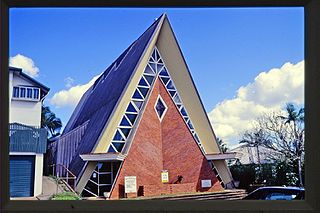
St Andrew's Presbyterian Memorial Church is a heritage-listed former Presbyterian and Uniting church at 114 Rankin Street, Innisfail, Cassowary Coast Region, Queensland, Australia. The former church was designed by Eddie Oribin and built in 1961 by Andrew George Pepper in the Modernist organic style and was also known as St Andrew's Presbyterian Church. The former church was added to the Queensland Heritage Register on 12 December 2003.

Innisfail Water Tower is a heritage-listed water tower at Mourilyan Street, East Innisfail, Cassowary Coast Region, Queensland, Australia. It was built from 1933 to 1934 by Van Leeuwen Brothers. It was added to the Queensland Heritage Register on 6 August 2010.

McCowat's Farm is a heritage-listed plantation at McCowat Road, Garradunga, Cassowary Coast Region, Queensland, Australia. It was built in 1920 by William Purdy. It is also known as Koodla. It was added to the Queensland Heritage Register on 21 October 1992.

Canecutters Memorial is a heritage-listed memorial at Fitzgerald Esplanade, Innisfail, Cassowary Coast Region, Queensland, Australia. It was designed by Renato Beretta and built in 1959. It is also known as Pioneers of the Sugar Industry Monument. It was added to the Queensland Heritage Register on 29 April 2003.

St Saviour's Anglican Church is a heritage-listed former church building at 26 Hynes Street, South Johnstone, Cassowary Coast Region, Queensland, Australia. It was built from 1938 to 1939 by Mose Romano. It was added to the Queensland Heritage Register on 24 September 2004.
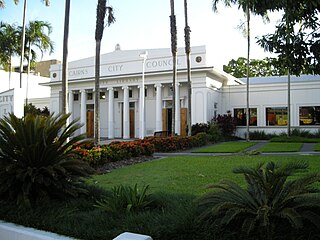
Hill & Taylor were an architectural partnership in Cairns, Queensland, Australia. A number of their works are now heritage-listed.
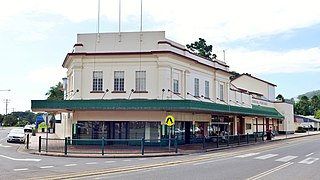
Mossman Shire Hall and Douglas Shire Council Chambers is a heritage-listed former town hall at 8-14 Mill Street, Mossman, Shire of Douglas, Queensland, Australia. It was designed by Hill & Taylor and built in 1937 by Tarmey & Euhus. It was added to the Queensland Heritage Register on 6 August 2010.

National Bank of Australasia Building is a heritage-listed former bank at 11 Mill Street, Mossman, Shire of Douglas, Queensland, Australia. It was designed by Lange Leopold Powell and built from 1935 to 1936 by Arthur E Zillfleisch and Tom Booth. It was added to the Queensland Heritage Register on 6 August 2010.
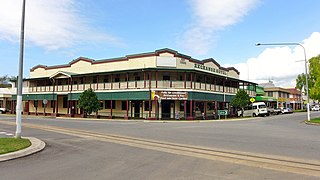
Exchange Hotel is a heritage-listed hotel at 2 Front Street, Mossman, Shire of Douglas, Queensland, Australia. It was designed by Vibert McKirdy Brown and built from 1934 to 1935. It was also known as Daintree Inn. It was added to the Queensland Heritage Register on 9 November 2012.

Barron Valley Hotel is a heritage-listed hotel at 53 Main Street, Atherton, Tablelands Region, Queensland, Australia. It was designed by Hill & Taylor and built from 1940 to 1941. It was added to the Queensland Heritage Register on 5 February 2010.
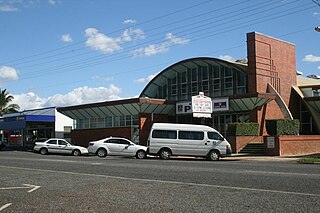
Mareeba Shire Hall is a heritage-listed former town hall at 136 Walsh Street, Mareeba, Shire of Mareeba, Queensland, Australia. It was designed by Eddie Oribin and built from 1960 to 1961 by Ernest William Lepinath. It is also known as Former Mareeba Shire Hall. It was added to the Queensland Heritage Register on 11 October 2013.

Murgon Civic Centre is a heritage-listed town hall at 62-70 Lamb Street, Murgon, South Burnett Region, Queensland, Australia. It is also known as Murgon Public Hall. It was designed by Clifford Ernest Plant and built in 1938 by HG Neilsen. It was added to the Queensland Heritage Register on 9 November 2012.

























